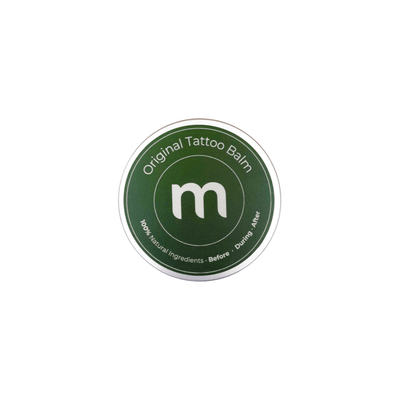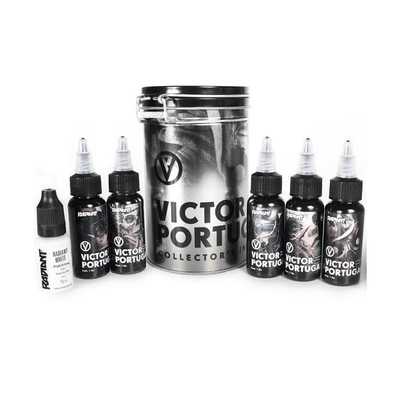As tattoo artists, you play a special role in capturing the bonds between pets and their owners through your art. So, we will offer key tips to help you perfect your pet portrait tattoos, from getting the initial outlines just right to mastering the detailed shading and colouring that bring these portraits to life.
We'll cover everything from choosing the right photos and poses to capture the pet's personality to understanding the nuances of different tattoo styles that can enhance your designs. These insights will help you create tattoos that are beautiful and deeply meaningful to your clients.
Tattoo techniques for capturing the personality and likeness of pets

Outline and detailing
A precise outline is foundational in pet portrait tattoos. Artists must focus on capturing every curve and characteristic unique to the animal. This starts with a detailed sketch, often based on high-quality photographs, ensuring that all elements, especially the eyes and facial structure, are accurate.
The transition from sketch to skin involves careful stencilling, and using a fine liner needle is crucial for capturing intricate details like the texture of fur or feathers. Each stroke should be deliberate, enhancing the depth and dimension of the portrait.
Shading and colour
Shading is where the portrait truly comes to life, giving it a three-dimensional appearance. Techniques like whip shading and smooth shading are essential for replicating the variations in fur tones and the subtleties of muscle tone and bone structure.
Artists must choose between monochrome or colour tattoos carefully—colour tattoos require a deep understanding of colour theory to accurately mix and match inks that reflect the pet's natural hues.
Layering colours in thin, translucent layers can create a more vibrant, lifelike quality, which is especially important in animals with uniquely coloured or patterned fur.
Incorporating character
Beyond physical likeness, capturing the pet's character personalises the tattoo. This involves emphasising certain traits or poses the owner identifies as quintessential to their pet.
For instance, a dog tilts its head when curious, or a cat's relaxed pose when lounging in their favourite spot. These elements can be accentuated by emphasising certain details like the sparkle in the eyes or the playful tilt of the ears.
Here, the artist must also engage closely with the pet owner, using their insights and stories to guide the tattoo's emotional expression.
Fur texture techniques
The texture of the animal's coat is another critical aspect that requires specialised techniques. Using a combination of line weights and shading, artists can mimic the look and feel of different types of fur.
Short, jabbing strokes can replicate short-haired animals, while long, flowing lines can be used for animals with longer fur. The direction and length of each stroke should follow the natural growth patterns of the animal's coat to enhance the realism of the tattoo.
Expressive eyes
Eyes are often said to be the window to the soul, and this is especially true in pet portraits. Capturing the gloss and depth of an animal's eyes is essential for conveying their spirit. This can be achieved through the careful layering of colours and reflective highlights.
A slight misstep here can change the pet's expression, so this step requires precision and sometimes a lighter hand with diluted inks to build up the necessary depth gradually.
How to use various tattoo styles for pet portraits

Using different tattoo styles for pet portraits can create unique and meaningful pieces of art. Here's a breakdown of how various tattoo styles can be applied to pet portraits:
- Traditional: Known for its bold lines and vivid colours, the traditional tattoo style uses classic motifs like roses and skulls. In pet portraits, this style can vividly depict your pet, often including decorative elements like names or special dates.
- Realism: This style is all about capturing lifelike details and creating tattoos that can resemble photographs.
- Watercolour: Characterised by its flowing, vibrant colours without solid outlines, watercolour tattoos mimic the effect of watercolour paintings.
- Tribal: Featuring bold black lines and symmetrical patterns inspired by Indigenous art, tribal tattoos emphasise form and design. When used for pet portraits, this style can highlight specific pet features through unique patterns.
- Neo-traditional: This is an evolution of the traditional tattoo style, incorporating more intricate details and a wider range of colours. Neo-traditional tattoos are perfect for pets with distinctive features, enhancing the portrait with depth and vibrancy.
- Japanese (Irezumi): Japanese tattoos are large and colourful and often tell a story using elements like koi fish and cherry blossoms.
- Portrait: Focusing on realism and emotional depth, portrait tattoos aim to capture the subject's essence. For pets, this style is particularly suited for memorialising a beloved animal with a focus on its facial features and expressions.
- Geometric: Using geometric shapes to create abstract designs, this style transforms subjects into modern, stylised artwork. Geometric pet portraits might simplify a pet's form into shapes like triangles and circles, offering a unique, artistic representation.
- Blackwork: Primarily using solid black ink, blackwork tattoos are versatile, ranging from intricate patterns to bold silhouettes. For pet portraits, blackwork can be particularly striking, offering stark contrast and focusing on silhouette or textured patterns.
Tips for working with clients to select the best photos and poses

- Inform clients about the need for high-resolution, clear, and well-lit photographs to capture detailed features.
- Encourage clients to choose poses that reflect their pet's personality and emotional significance.
- Guide clients on selecting a pose that complements the tattoo's placement on the body, considering the available space and visibility.
- Advise on choosing photos with natural lighting to enhance depth and detail in the tattoo.
- Suggest selecting a photo with emotional significance, capturing a memorable expression or moment.
- Offer expert advice on which photos will work best technically and artistically for a tattoo.
- Provide preliminary sketches or digital mock-ups to help clients visualise how the tattoo will look and make adjustments if necessary.
Final thoughts
The key to excelling in pet portrait tattoos lies in your ability to collaborate closely with pet owners, understand their vision, and translate it into the skin with skill and sensitivity.
Armed with these expert insights, you are equipped to elevate your pet portraits, creating tattoos that are not only visually stunning but also emotionally resonant, making each piece a lasting tribute to the bond between pets and their owners.




























































 Studio supplies
Studio supplies












 Power & batteries
Power & batteries







 Aftercare
Aftercare



















 Apprentice
Apprentice


 Piercing & jewellery
Piercing & jewellery







 PMU supplies
PMU supplies



 New arrivals
New arrivals
 Gift vouchers
Gift vouchers
 Shop all
Shop all










































